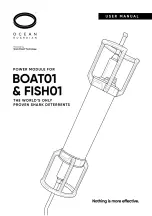
-26-
5. You’re in your service vehicle. You’re Redi-Line generator needs repair, or your wiring needs replacing
(usually from the battery to the Redi-Line), or your battery is weak. Another possibility is that you’ve been
using a power converter and it is marginal.
6. Your cutter wheel is really dull.
Stylus Shaves Material Off Key
The situation is caused by the fact that the cutter wheel is made to a sharp point and therefore to cut keys accu-
rately the stylus must also be made with a sharp edge. A key blank dragged across a sharp edged stylus has
no choice but to scrape material from the key blank. The solution is to lightly “blunt” the sharp edge of the sty-
lus. This has to be done carefully because if the edge of the stylus is blunted to much you will narrow the width
of the pin seat somewhere in the middle—if the stylus is sharp it will scrape the key to much, if the stylus is
blunted to much it will produce a duplicate key with a slightly narrower pin seat area.
If you’re going to cut more than 5 or 10 duplicates off one key we recommend that you make “first” generation
keys and then make additional duplicates off of them. For example if you had to make 50 duplicates off the
same key you should make 5 or 10 “first” duplicates and make 5 or 10 duplicates off of each of them. This is a
classic example of why your key machine should always be maintained in perfect depth and space adjustment.
Cutter Leaves Ridges on Cut Key
This situation is related to the example above. The cutter wheel is made with a dead-sharp edge or point. You
will always get ridges on the cut surface when the cutter has sharp pointed teeth The ridges will get smoother as
the cutter wears—until finally you have to buy a new cutter or get the old cutter resharpened,. When you put on
the new or resharpened cutter you’re back to ridges again.
Machine Makes Whirring Sound
There are four possible causes.
1. The sound is coming from the motor. With the machine turned OFF-grab the motor shaft and try to get
some movement out of tit when trying to move the shaft up and down. If there is up and down movement
the motor ball bearings are worn and the motor will need replacement some time in the future. Please ig-
nore any motor shaft play when pushing or pulling the shaft along its length in and out of the motor—this
play is in the motor’s spring preloaded ball bearings and is not a sign of bearing wear.
2. Your drive belt is coming apart or is frayed. Replace it.
3. Your ball bearing cutter wheel shaft assembly is wearing out. With the machine turned OFF—grab the cut-
ter wheel’s left-hand nut and try to get some movement out of it. There should be absolutely no move-
ment—if there’s movement in the bearings you need to replace the cutter shaft assembly. If there is no
movement it may be the other bearing next to the drive pulley—you will have to remove the drive belt to be
able to check it out. Another possibility is the way some of the ball bearing cages are made inside the bear-
ings—these ball cages have an assembly opening created at the bearing factory. These bearings some-
times make a slight “ticking” sound. In this case the sound may not be a problem.
4. The machine’s cutter shaft lock is partially depressed and is rubbing against the drive pulley. Pull up on the
shaft lock knob and the sound should disappear.
Machine Won’t Start
There are several things that can cause this besides the obvious—plug in the machine and check the power
line.
1. If you are running 12 Volt D.C.—check the fuse and ALL the wiring and connections.








































